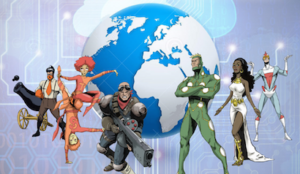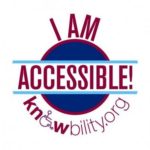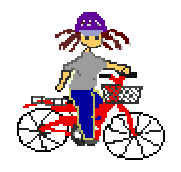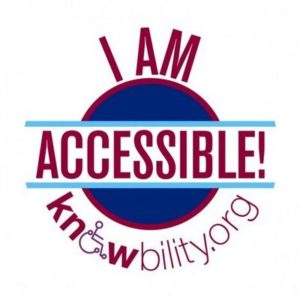 I am thrilled to announce, at last, that I am working with Knowbility, a nonprofit based in Austin, Texas with whom I’ve been working with on and off since its founding in 1998. And even better: what I’m doing will help nonprofits, non-governmental organizations (NGOs), charities, schools and others to be able to welcome more clients, more donors, more volunteers and more supporters via their web sites.
I am thrilled to announce, at last, that I am working with Knowbility, a nonprofit based in Austin, Texas with whom I’ve been working with on and off since its founding in 1998. And even better: what I’m doing will help nonprofits, non-governmental organizations (NGOs), charities, schools and others to be able to welcome more clients, more donors, more volunteers and more supporters via their web sites.
I am the Knowbility liaison for nonprofits, NGOs, schools and other mission-based organizations that will participate in OpenAIR 2018 . OpenAIR is my very favorite group volunteering gig and hackathon anywhere in the world. This Accessibility Internet Rally (AIR) by Knowbility was a hackathon before there was the word hackathon. It was an onsite, local event for many years, and is now an international virtual volunteering event!
Via OpenAir, mission-based organizations get professionally-designed, accessible websites that accommodate all visitors. In fact, via OpenAir, they get more than a shiny new web site; they become a more-welcoming organization online – and maybe offline as well. This is a life-changing event for many participants – expect to have your horizons expanded and your way-of-thinking about how people use online tools transformed!
People with disabilities want to donate, volunteer and otherwise support causes they care about. Like all people, they love the arts, animals, and the environment, they enjoy beautiful parks and fun outdoor activities, they support education, they want serious social problems addressed, and they want to be involved in these causes – as employees, as donors, as volunteers and as clients. But if your organization’s web site isn’t accessible to them, you leave them out – and that means you leave out potential donors, volunteers, clients, ideas, talent and more. All of that changes when your organization participates in OpenAIR! Here’s more about what accessibility means and why it’s important.This is a GLOBAL event: participating nonprofits, NGOs, charities and other mission-based organizations can be anywhere in the world!
This is a GLOBAL event: participating nonprofits, NGOs, charities and other mission-based organizations can be anywhere in the world!
I am SO EXCITED about my role, and I can’t wait to start helping nonprofits and others participate! In September and October, I will market the heck out of this event, and I hope you will help by:
- sharing this blog that you are reading now via your social media and in emails to colleagues and associates
- by retweeting tweets that use the hashtag #OpenAIR2018
- by following @Knowbility on Twitter, liking the Knowbility Facebook page and liking all messages related to OpenAIR
- by talking to nonprofits, NGOs and charities you know that either don’t have a web site, or have a web site but it’s in need of a redesign, and encouraging them to check out the nonprofit section of the OpenAir web site.
In fact, you don’t have to wait – you can start doing all that NOW.
In November and December 2017, and in January 2018, I will be knocking myself out doing everything I can to help participating nonprofits prepare their information for their design teams, so that those teams can get started on their web sites in February – these design teams have just six weeks to develop these sites as a part of the OpenAir competition! Judging and awards will take place in March 2018. Participating nonprofits pay $100 to participate in OpenAir, but that fee isn’t due until December 2017, and the informational webinars in September and October about accessibility and the competition will be free.
The web designers in OpenAIR are professionals who want to apply their accessibility design skills to a web site for an organization doing good in the world. Each design team pays a small fee to participate, and commits to several hours of classes by Knowbility regarding the latest web accessibility tools and techniques. These design teams are mentored by leading experts in the accessibility field throughout their design time during OpenAIR. The designers that participate in OpenAIR are professional, trained web designers working for a variety of companies and universities. Since 1998, OpenAIR (then AIR) has included teams of web professionals from IBM, Dell, Applied Materials, Google, GivePulse, TradeMark Media, Elemental Blend, Cognizant Technology Solutions, Cal State, University of Michigan, University of Southern Florida and many more. For Knowbility, these teams are volunteers, donating their time and talent to create high quality, professional websites for participating organizations. If your company or university or group of friends wants to form a design team to participate and support a nonprofit or NGO in creating its web site as a part of this competition, please see this OpenAIR design team information.
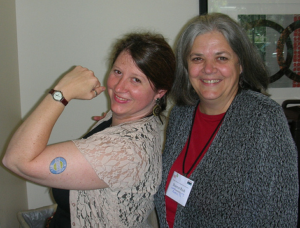 Can you tell I’m excited?! This is a dream gig for me: I adore the work of Knowbility beyond measure (at left is a photo of me and Sharron Rush, a co-founder of Knowbility and its Executive Director, at a conference in 2006, with me displaying my “are you accessible?” temporary tattoo), I had a blast being a part of the AIR events almost 20 years ago, back when they were onsite in Austin, I am passionate about web accessibility, I love how corporations walk away from this event with much more awareness about the work of nonprofits, and I love helping nonprofits! This means, however, that I’m not available for any consulting gigs until after February 2018. So if you are thinking of me as a consultant for next year, contact me ASAP, as my schedule fills up quickly! More about my consulting services.
Can you tell I’m excited?! This is a dream gig for me: I adore the work of Knowbility beyond measure (at left is a photo of me and Sharron Rush, a co-founder of Knowbility and its Executive Director, at a conference in 2006, with me displaying my “are you accessible?” temporary tattoo), I had a blast being a part of the AIR events almost 20 years ago, back when they were onsite in Austin, I am passionate about web accessibility, I love how corporations walk away from this event with much more awareness about the work of nonprofits, and I love helping nonprofits! This means, however, that I’m not available for any consulting gigs until after February 2018. So if you are thinking of me as a consultant for next year, contact me ASAP, as my schedule fills up quickly! More about my consulting services.
Direct links from the OpenAIR web site for nonprofits:
I can’t wait to work with you! In fact, if you are in the Portland, Oregon metropolitan area, I would be happy to talk with you face-to-face, in-person about participating in this event. Just contact me at jc@coyotecommunications.com to set up a time and place!
 I had never captioned videos ever until recently, and in the last eight weeks, I’ve captioned four, via YouTube’s free tool. My conclusion: there is NO reason that your organization’s videos should not be captioned. None. Zilch. Nada. If I can figure it out, anyone can.
I had never captioned videos ever until recently, and in the last eight weeks, I’ve captioned four, via YouTube’s free tool. My conclusion: there is NO reason that your organization’s videos should not be captioned. None. Zilch. Nada. If I can figure it out, anyone can.
